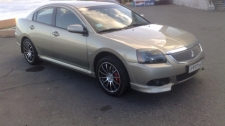However, there are a few problems.
For example at the intake valves. The distance between the saddles more than 6 mm.
It's all good, can make a +4 mm. However, on the other side of the valve is really bad.
In the picture where the screwdriver is. This place is not to increase more than 1 mm.
Even if you increase more than 1 mm, then this place is not the movement of the air flow.
- - - Updated - - -
The same problem with the exhaust valves.
So. The maximum that can be supplied is +2mm intake, +1.5 mm exhaust.
- - - Updated - - -
First, remove the seat.
- - - Updated - - -
New seat mounted with an interference fit.
As you can see, the size of the saddle a lot more than internal size.
After installation of the valve seats, it is necessary to cut the working chamfer. At a certain angle. For example, here is a video as to cut the chamfer. It's a different cylinder head (4G63). But the meaning is the same.
http://www.youtube.com/watch?v=WYqOQGiKnyY
- - - Updated - - -
After the valve seats. Need to find new valves. I originally planned to install the valves from car Honda NSX. Inlet 36mm, exhaust 32mm. But these plans had to be abandoned. These valves are not the same length. They are much smaller.
I've been looking at different catalogs from different manufacturers. Ultimately bought the prefabricated. From Ferrea.
Ferrea Competition Plus Valves have built a reputation as the industry's most reliable extreme duty valve. To manufacture the valves we use special aerospace quality alloys, including the EV8-Z18, which provides high tensile strength. An exclusive two-step slow forging process ensures proper grain flow and virtually eliminates any damage to thematerial structure. The valves are then heat-treated and stress-relieved over a 48-hour period, which is the crucial base of our molecular integrity. These valves feature avionics-quality hard chrome along with a specially applied hard tip.
- - - Updated - - -
Final length is measured after full preparation. For example, the measured length of the stock valve.
This length takes as a starting point 0.00
Next, measure the new valve
As you can see in the photo, the length is longer at 0.211 mm
Further, the end valve grind 0.00
- - - Updated - - -
I also want to say. The thickness of the stock valves 6mm. New valves intake also 6mm.
And the valves on the exhaust have a smaller thickness. 5.5 mm
- - - Updated - - -
Next you need to pick up and replace the bushings valves. To do this, use the bronze bushings from Honda. Bronze better heat dissipation than cast iron.
To the left of the Honda, right stock.
Since I do not plan to greatly increase the engine rpm (maximum 7200 rpm), I leave the springs stock. For exhaust valves decreased the thickness of the valve stem. Therefore we must find new retainers. I also use Honda.
Stock
Honda
- - - Updated - - -
In the area of the 4th cylinder there is a channel of exhaust gases for the EGR. I disconnected this valve software. This channel should be mute. It will not heat the cylinder head. This will allow you to use a plastic intake manifold. It will also give a more even flow of gases from the 4th cylinder.
This is undercut in the body of the channel.
Next is plugged.
In the future, all the projecting parts are ground down.
- - - Updated - - -
After replacing valve seats and bushings, it is possible to broaden the channels for intake and exhaust.
However, it is impossible to mindlessly increase the channels. The intake channel has just such a form
If you just increase (expand) the input. The fall in the rate of air flow. Therefore, the form should remain as shown above.
- - - Updated - - -
Now the Assembly can start.
In General, everything seen in the photos
- - - Updated - - -
- - - Updated - - -
Now it is necessary to conduct a air flow test. Reinstall the head on the purge stand.
- - - Updated - - -
So, the result of the flow test. 298 CFM Intake, 214 CFM Exhaust
I did a test before the valve lift of 13 mm (.512) Further lifting does not make sense. There is simply no camshaft with the same lift. But if I do as is customary in the US to 15mm (.590) It will be well over 300 CFM.
Another graph overlay of stock vs ported
Improvements over the entire range of the valve opening. From the bottom to the top.
- - - Updated - - -
I want to say that this engine is 300 HP (N/A)
At this point I will finish this topic.
PS The issue price? In Russia the work and cost of parts is $ 2,500. Expensive? Maybe, but it's worth it.
Stayer
 Log in
Log in Register
Register




 2010 Mitsubishi Galant ES
2010 Mitsubishi Galant ES




 Reply With Quote
Reply With Quote

































Bookmarks